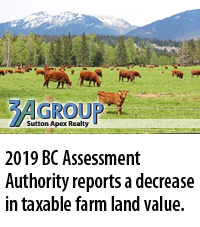The 2019 BC Assessment Authority reported a reduction in farm land taxable values for all regions of the province in their January Assessment reports. This can be misinterpreted when you are unaware of how and why B.C. Assessment collects and processes its findings. Only the “land” itself that is approved for farm status is included in this farm land value calculation. Meaning that you may have a 5 acre farm and only the 4 acres in agricultural production are assessed as farm. The other 1 acre of land is used for residential purposes and is assessed in the Residential Value category in that regions statistics. This is known as split classification. It is the mandate of the BC Assessment authority to process all farm status applications and accurately represent the “farm” land counted in its statistical data meant for property taxation purposes. When a property is classified as farm by B.C. Assessment, the value is assessed at rates set by the provincial government. The assessed value is lower than the assessed value for residential, commercial or industrial land. This results in lower property taxes, and is one of the methods used by the B.C. Government to encourage farming. B.C. Assessment uses legislated Farm Land Value Schedules set by the Lieutenant Governor through the Assessment Act, LAND VALUES FOR FARM LAND REGULATION. The Land Value Schedules rate land according to “land capability” or “soil capability” and respectively to “Soil Capability Classification for Agriculture. It is through this method that the taxable land value of each farm status property is determined.
The figures released by the B.C. Assessment Authority for 2019 is ultimately showing that farm land taxation values have seen a reduction in every region. Farm land is not assessed at market value, but at its value in farm use only, without regard to its value for other purposes. The overall market value of farm land has not decreased in the province. Farm Credit Canada historical statistics report that B.C. Farm Land has increased in market value every year since 2011. Over the last seven years the biggest valuation increase was in 2016. In 2017 the FCC data reports the Vancouver Island market having very few properties for sale in 2016 and 2017 and that the bulk of sales was in the area of farm land expansion of existing producers.
BC Assessment historical stats show Property Count by Property subclass. In 2016, 09-Farm land total property count was 51,560. In 2017 that number increased to 51,817. In 2018 a decrease in the amount of farm property counted at 51,043. This decrease of 774 farm properties was again reduced another 43 properties in the 2019 count for a current total of 51,000. The reason for this decrease in assessment counts of farm status land could be attributed to several factors. Being a voluntary program, in any given year, there are farms that no longer qualify or the applications are not received or not assessed in time to be counted. This makes the BC Assessment farm values and property count fluctuate year to year. The reduced count could in part be attributed to farmers and ranchers who have retired over the past couple of years. Furthermore, farm and ranch land has become increasingly sought after for uses other than agriculture. The Fraser Valley and Vancouver Island have seen unprecedented urban growth and agricultural farm land has seen increased pressure by residential development and applications to change property zoning to remove it from the Agricultural Land Reserve.
The ALR was created in 1973 to protect 4.7 million hectares of farmland, because only five per cent of B.C.’s land area is considered suitable for agriculture. At that time more than 6,000 hectares of farmland was being lost to development each year. Since its inception in 1973, the Agricultural Land Commission (ALC) has considered over 45,000 land use applications to remove land from the Agricultural Land Reserve (ALR), to subdivide land within the ALR, to use agricultural land for non-farm purposes or to include land into the ALR. The ALC reviews 500 to 700 new applications each year.
The provincial government tabled new legislation in November 2018, and If passed, Bill 52, the agricultural land commission amendment act, 2018, will strengthen protections for B.C.’s Agricultural Land Reserve. It will address issues facing our agricultural land including the purchase of farmland for large residential residences and the dumping of construction debris, toxic waste and other fill in the ALR that can irreparably damage arable soil on valuable farmland, through increased penalties. All owners of land used for agricultural purposes in B.C. are urged to apply for farm status with the B.C. Assessment Authority, it helps identify where the changes in land use are, keeps farm land taxes lower, and ultimately strengthens the agricultural industry in our province.


